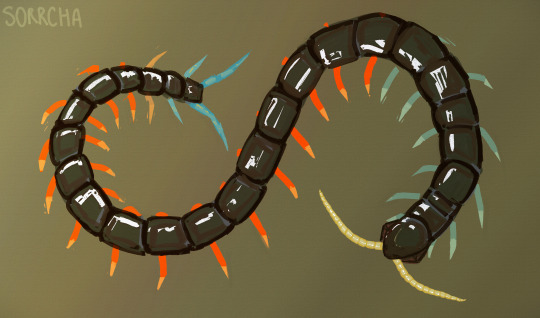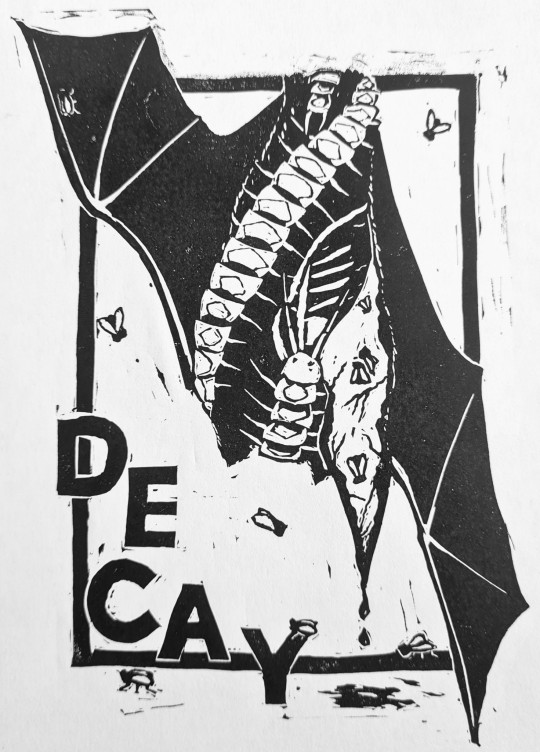#there was a giant centipede
Explore tagged Tumblr posts
Note
Ragapom and Abstrabbit double date?

They tried a double date once! It didn't turn out well....
#the amazing digital circus#tadc#amazing digital circus#digital circus#pomni#ragatha#jax#zooble#pomni x ragatha#ragatha x pomni#jax x zooble#zooble x jax#there was a giant centipede#they had to fight it#Ragatha lost
56 notes
·
View notes
Text

Stone-eating oomukade
809 notes
·
View notes
Photo



African giant centipede, Ethmostigmus trigonopodus, Scolopendridae
Photographed in South Africa by Bernard DuPont
#animals#curators on tumblr#bugs#myriapods#centipede#african giant centipede#scolopendridae#one nice bug#bug death#predation
997 notes
·
View notes
Text

scolopendra sp. "malaysian jewel"
#halfheartedly throws a bug at you. take this#art#digital art#ms paint#animal#arthopod#bug#centipede#giant centipede#bugblr#hall of fame
697 notes
·
View notes
Text
i'm excited to get (i hear skittering above me) i mean purchase OFF in 2025
151 notes
·
View notes
Text

#my art#mcr#my chemical romance#animal death#did u know a giant centipede can actually kill a bat ! i saw it on david attenborough yesterday
1K notes
·
View notes
Note
What's your process like for moving your centipedes around for tank cleaning? Since they're so keen on stinging.

I’ve gotten very good at moving scared, defensive centipedes by gently grasping them in long forceps, helpful demonstrator here is Mercédès, Scolopendra hainanum. the trick is to 1) don’t let them touch you and 2) don’t breathe on them, or they’ll freak out.
I also do all of my centipede work in or over a very large plastic tub—they can’t climb smooth surfaces, so in the event of an escape they’ll just wander around there until I put them back in their home.
if I’m in a silly mood though sometimes I coax them into a bottle or tube to wait:


1x VIAL of AGATHA (1/1 uses remaining)

and release:
scolopendromorphs are comforted by small crevices, so they’re actually quite calm in there. a good way to check up on their mouth and digestive health as well! I don’t recommend getting this close to big scolo if you’re not very experienced though
(Scolopendra hainanum, Scolopendra mutilans)
4K notes
·
View notes
Text

#centipede#milipede#bugblr#emptycore#bugs#insect#giant millipede#shongololo#tw bugs#tw insects#chaos aesthetic#dark aesthetic#unsettlingcore#unreality#surrealcore#weirdcore edit#strangecore#oddcore#weirdcore#liminal aesthetic#chaoscore#strange aesthetic#weird aesthetic#weirdcore aesthetic#paranormal#paranormal aesthetic#tw unsettling#unsettling imagery
124 notes
·
View notes
Text

For sticky day
I grossly overestimated myself so this is all
#alien stage#alnst#doodle#sketch#alnst ivan#ivan#mizi#alnst mizi#luka#alnst luka#witch#fairy#giant red head centipede#orchid mantis#moth
164 notes
·
View notes
Text

more necromancer doodles. u guys will hear more about this guy eventually 💀
#i ran a poll on twitter abt whether it would be funnier for his centipede 'familiar' to be completely useless and unmagical#i.e. literally just a normal giant bug#or if it's funnier for it to be a magical talking centipede but it's still useless and doesn't do anything#it's just that it also sometimes says stuff like 'nhyyeahhhh boss you tell em!!' and 'i'm a woim!!!!!'#but at the end of the day i am going w the former bc. it is very important to me that this character is excruciatingly lonely#and if his giant bug pet could talk to him that would be too much relief. 🖤#ANYWAY. thats all for now#back to comms#my art#my ocs#vega mauserot
321 notes
·
View notes
Text



Next minute you know, there was a giant centipede on his arm but he was too busy acting cool to notice it 🫣




Aaaand some extras!!!
#ts4#sims 4#ts4 gameplay#ts4 legacy#tjol legacy#tjolc#tjolc gen 1#suzume miyazawa#oscar valenzuela#AHAHAHA THIS WAS ABSOLUTELY HILARIOUS BUT UNXPECTED#the centipede was stuck on him!#he was doing the confident walk#and it matched my vision with trying to act cool...a hey wassup look#doesn't it look like that lmao#dont worry hes fine haha#now thats something to freak out about a giant fucking centipede#sorry i scared some of you with the “but” i wanted you to guess what could have possibly happened THEN SHOW THIS! if you think aboutit#it is “bad” with his luck!!#but at least its a memorable date!!
108 notes
·
View notes
Text






bugs
#bugblr#bugs#millipede#centipede#weevil#mantis#praying mantis#orchid mantis#snail#giant african land snail#giant african millipede#black tarantula#isopods
71 notes
·
View notes
Text
Round 2 - Arthropoda - Chilopoda




(Sources - 1, 2, 3, 4)
Chilopoda is a class of arthropods commonly called “Centipedes”. They include the Scutigeromorphs (“House Centipedes”), Lithobiomorphs (“Stone Centipedes”), Scolopendromorphs (“Tropical Centipedes”), Geophilomorphs (“Soil Centipedes”), and the Craterostigmomorphs which consists of only two living species.
Centipede means “hundred feet”, though no species of centipede actually has exactly 100 feet, as their pairs of legs are always an odd number, ranging from 15 to 191 pairs of legs! All centipedes are venomous predators, delivering venom through a pair of fang-like front legs called forcipules. Prey include other invertebrates like earthworms, fly larvae, collembolans, and other centipedes. The giant Scolopendromorphs are able to tackle larger prey including vertebrates such as lizards, frogs, birds, mice, snakes, and even bats. They live in tropical or desert habitats worldwide, but only in moist environments, meaning they must be more active under cover or at night. Many species lack eyes, though some have simple eyes that allow them to distinguish light from dark. Some species use their first pair of legs similarly to antennae, sensing vibrations and even using them to “hear.” Their bodies consist of 15 or more segments, with one pair of legs attached to the sides of each segment. Their back legs, called “ultimate legs”, are modified depending on species, and can be elongated and thin, thickened, or pincer-like. They are not used for walking, but instead can be used in defensive displays, for hunting, or for interspecies fighting, and they often play a role in mating rituals and are usually sexually dimorphic. Centipedes range from a few millimetres to 30 cm (1 foot) long.
Centipedes are generally solitary, not even meeting up to mate. Males will leave spermatophores on the ground for females to pick up. However, females provide parental care, coiling around both their eggs and young and grooming them (first image). Some species grow anamorphically: adding on segments with each moult until they reach their adult number of segments. Some species grow epimorphically: growing all their segments and legs as an embryo before hatching, and not adding on any more when they moult.
Centipedes arose during the Late Silurian, but were considerably rare until the Triassic Period. The modern Scolopendromorphs and Scutigeromorphs appeared in the Cretaceous.

Propaganda under the cut:
In my desire to show just how colorful and beautiful centipedes could be, my first rendition of this post featured 3 Scolopendromorphs and 1 House Centipede. I then realized how unfair that was and changed it to include most of the major types of centipede, which reduced a lot of the color of this post unfortunately. I believe the centipedes I’ve chosen are still beautiful regardless, but if you want to see some pretty colorful centipedes, check out the rest of Scolopendromorpha!
Similarly to spiders, while all centipedes are venomous, none are particularly deadly to humans. Most small centipedes’ jaws are too small to break human skin, but large tropical centipedes’ bites can be quite painful: causing swelling, chills, fever, and weakness, especially in children and those allergic to bee stings. These bites are always in defense, so if you leave them alone, they have no reason to bite.
Some large centipedes are consumed in China, usually skewered and grilled or deep fried. Thailand produces centipede vodka: large centipedes steeped in alcohol.
The common house centipede (Scutigera coleoptrata) originated in caves in the Mediterranean, but has evolved alongside us to live inside human homes. The dark and humid corners of buildings are literally their habitat! They are beneficial predators, feeding on many species humans consider pests such as cockroaches, termites, ants, bed bugs, spiders, and silverfish.
Centipedes have long lifespans for arthropods, some living up to 10 years.
They are friends! Or maybe… lovers?
#ngl I LOVE house centipedes#i keep them in my house and they have the cutest tiniest babies and if you pick up the big adults and they realize you’re not gonna hurt#them they stop freaking out and go a lot slower and just like inspect your hand so softly and carefully#they are just panicky little eyelashes that eat bedbugs#they are friends and lovers#mad respect to people that keep the giant tropical venomous centipedes as pets though#round 2#animal polls#arthropoda
80 notes
·
View notes
Text

@webhoard submitted: Saw this Texas Redheaded Centipede in Wild Basin Preserve in Austin TX on Nov 29, 2024. The little guy (or gal! not sure which) was a bit cold and not moving too fast, so I scooped him up with a couple sticks and moved him off the asphalt to safety.
Oh, lorge....love this fella. Hope they're out there living their best centipede life, warm and cozy :)
398 notes
·
View notes
Text

Cryptid of the Day: Arkansas Giant Centipede
Description: On Sept 17th, 2023, Lon Strickler received an email detailing an Arkansas bow hunter’s encounter with a massive centipede devouring an injured deer. He guessed it was 10ft long, and was able to drag the carcass. He didn’t take a picture cause he didn’t have his phone on him
116 notes
·
View notes
Text
would you still love me if i was a giant centipede. would you still love me if i crawled up onto the cave ceilings in the pitch black. would youstill love me if i reached into the darkness to capture and consume a creature twice my size flying through the air. would you still love me if i was poisondos posuinous poisonis poisonous
#no more places its giant bat eating centipede hours 🙄🙄🙄 /j#not a place#bugposting 🫶#of course theyre not TRUE bugs quote unquote but i call them bugs anyways. because LIKE the giant centipede im notpicky#ill consume anything. any word any bird any BAT
346 notes
·
View notes